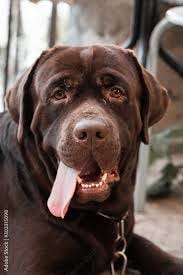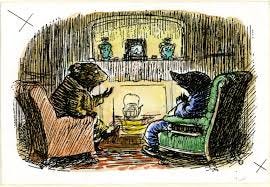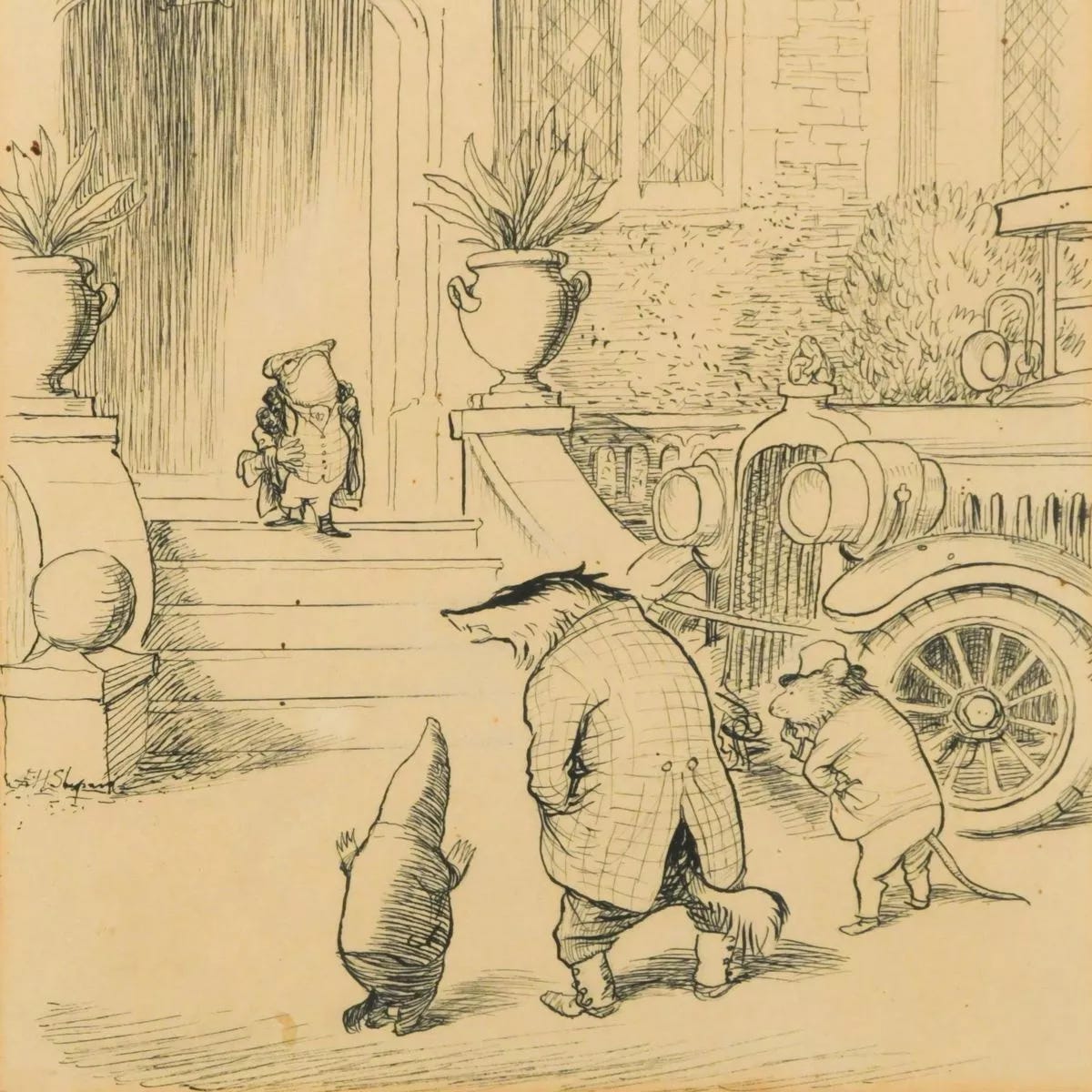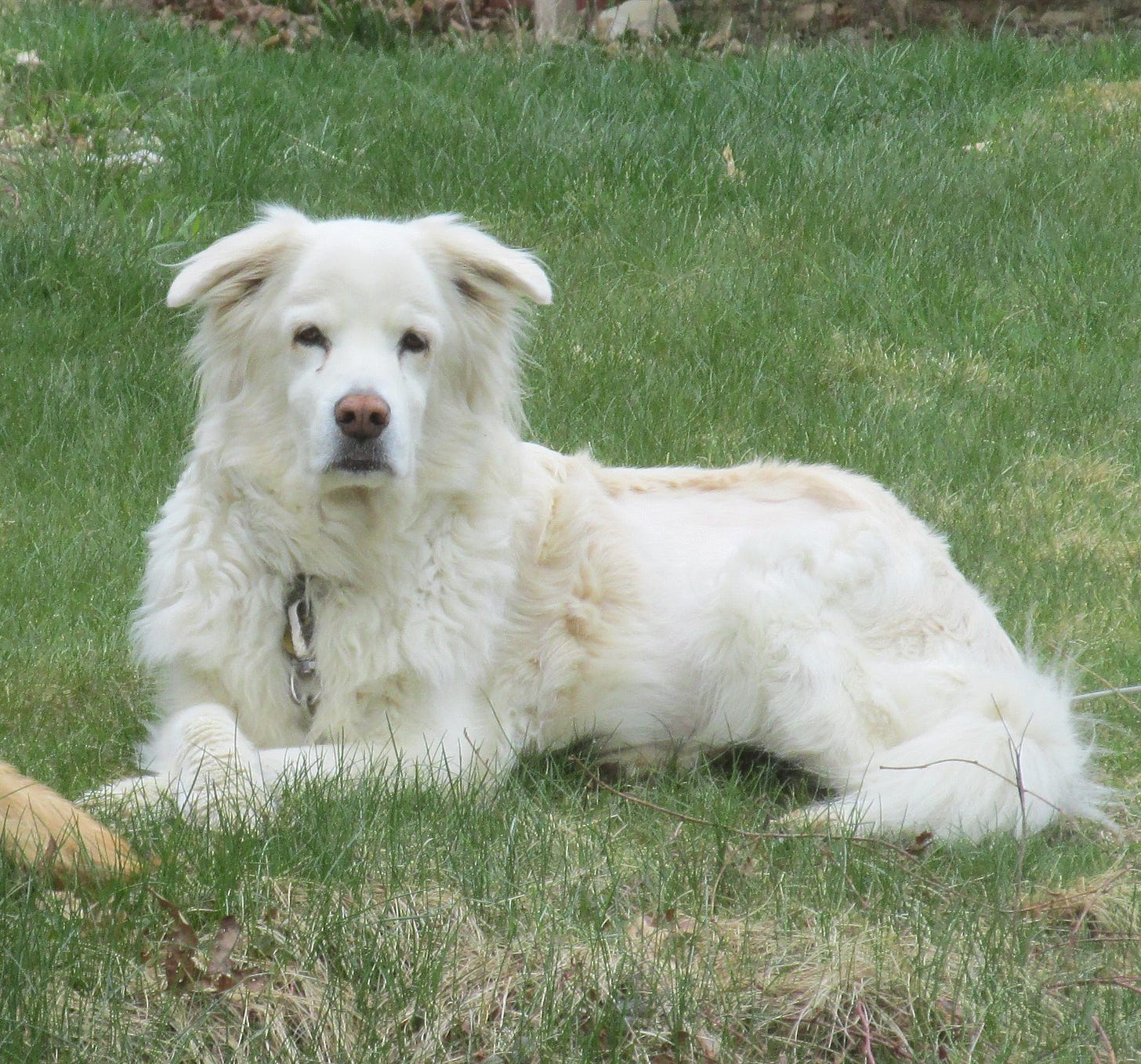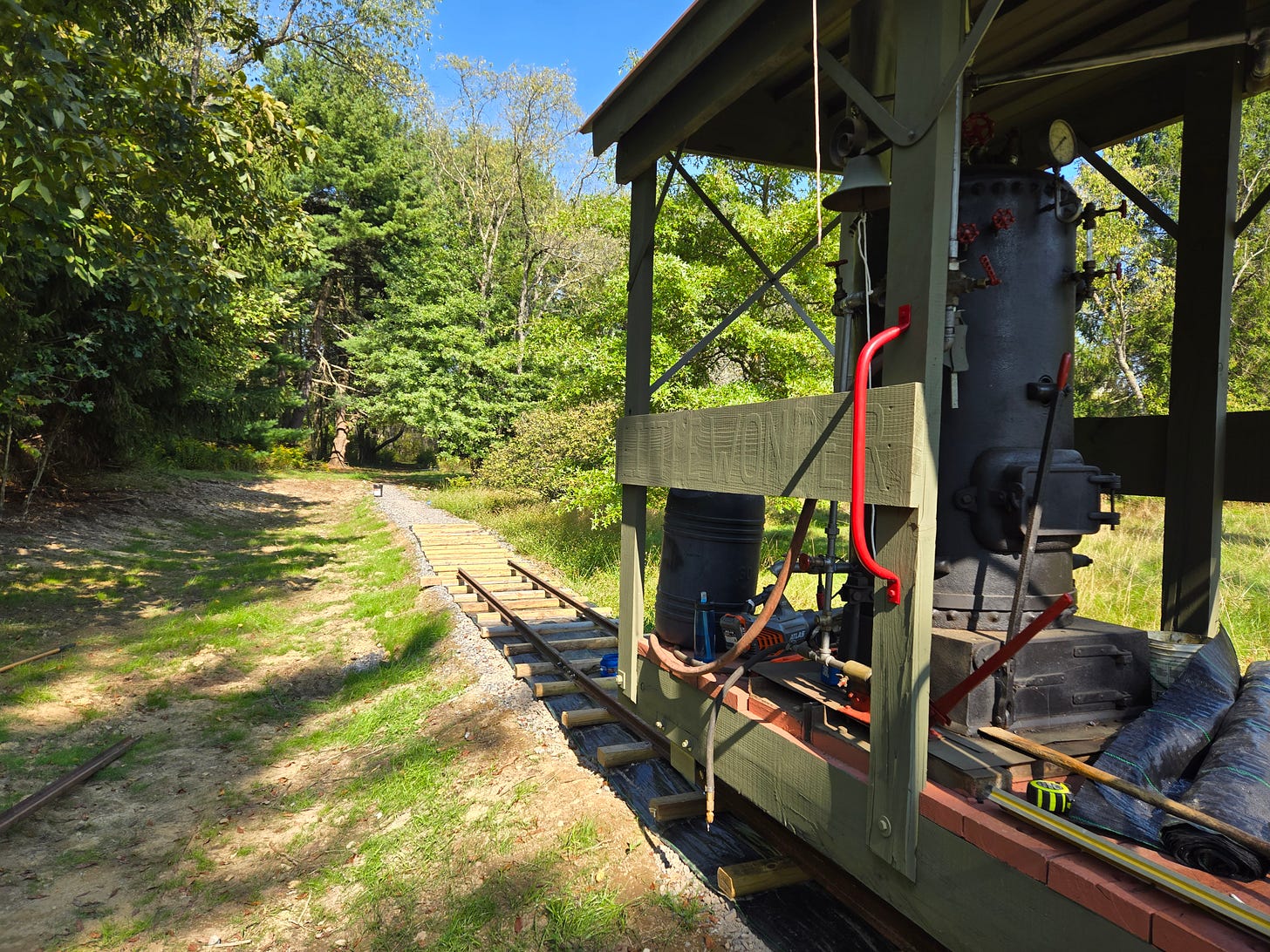When my daughter was in junior high she at times had friends do “sleepovers” particularly on the weekends. One time her friend Kelly was staying over, and she said to Lauren, “Who are your parents talking to when no one else is around?”
At first, Lauren didn’t know what Kelly was asking. I think Kelly then clarified, “They seem to use different voices and say funny things.”
Lauren then realized that Kelly was referring to our habit of giving voices to our pets, usually our dogs (or cats when we had some) and my parent’s big chocolate lab, Bear Parrott, who we would watch when they traveled, which was often.
Bear Parrott was quite a character. He looked kind of like this…
Bear Parrott was an infamous character around the neighborhood because of his habit of venturing out from my dad’s property to steal food on “garbage night.” We didn’t know about this until we watched him for our first winter in my parent’s old house while they went south to escape the cold of winter. At the spring thaw, the field between our house and the neighborhood was littered with plastic “butter bowls” or Cool Whip tubs, etc. We didn’t know where they came from. But either from my mom or a neighbor, we found out that the neighbors had developed a strategy to deal with the fact that every “garbage night” Bear would tip over their garbage cans and root around for food, leaving them a big mess to clean up. One of the neighbors came up with the idea to put a small tub of dog food beside the garbage cans which he would carry down the hill to our field and devour at his leisure.
Due to his insatiable appetite and large girth, my brother-in-law, David, dubbed him “That fat feral pig” (!)
I came up with his voice after something happened when we were heading out to work one morning. My wife Leslie was heading out the door, and she had picked up the many bags she needed to teach art classes - in one hand she was holding a donut which she hoped to eat for breakfast on her drive to work. As she made her way down the hall to the front door, she passed by Bear, who was snoozing on a large pillow in the entryway. Alert readers will no doubt have already guessed what happened. As she passed by Bear, he leaned over and deftly yanked the donut1 out of her hand and swallowed it in one cavernous bite. 2
Leslie yelled out “THAT MONSTER STOLE MY DONUT!!”
I heard that from the kitchen, and shortly thereafter came up with “Bear’s Reply.” It was along the lines of what you see in “Guilty Dog Videos” on YouTube (you need only watch about 20 seconds to get the idea.)
I made up a deep, somewhat sticky voice for Bear Parrott giving his formal apology,
“Aunt Weswey, I am very sorry that I stole your donut… But I was hungry…”
The rule I came up with was “the bigger the dog, the deeper the voice.” So Bear had a deep voice and mostly talked about stealing food. Here’s a Disney example of something similar:
“Dugg” the dog from Disney’s “Up!”
Note that Dugg doesn’t actually talk - his “voice” is provided for him. This is what we would do for the various dogs we have had over the years, from Bruiser, who I found wandering in downtown DuBois, to Max a miniature Shetland sheepdog who had a miniature voice, to Mick our Aussie Shepherd, to Tucker, our current terrier mix. Each of them had a distinctive voice and a range of emotions that suited their unique personalities.
The British penchant for “dressed animals” from “Winnie the Pooh” to “Chronicles of Narnia.”
I don’t think it is a peculiarly British thing to have talking animal characters in stories. One could think of Aesops Fables from ancient Greece, or Peter and the Wolf from Soviet Russia, but the British seem to have almost a cottage industry in producing such works. As seen here in Kipling’s The Jungle Book
One other feature of some of their animal stories is that they are highly anthropomorphized.3 What I mean by “highly” anthropomorphized is that in many of these tales, or fables, they are dressed in human clothing (though, oddly, often just on their top halves!) C.S. Lewis (who wrote The Chronicles of Narnia) referred to them as “dressed animals.” Not only do they wear clothing in some stories, but they also might live in houses with furniture, drive motorcars, and do many of the things that people do.
Some authors which come to mind are Beatrix Potter with her farmyard animals:
Kenneth Grahame’s The Wind in the Willows:
And, of course, Winnie the Pooh:
Who Killed Punxsy Phil?
About 25 years ago (Gosh, how time flies!) I wrote my attempt at a short humorous novella, Who Killed Punxsy Phil. I have been offering it as an E-book if you subscribe to this newsletter (which is also free.)
You can get your free copy if you hit the button here: (please ignore any paid subscription options. I do not yet have a “paid subscribers” version of this newsletter!)
Inspiration for the Story
I got the idea for the story because I was in a dance company4 in Punxsutawney, PA, and that winter the company director, Joan Van Dyke, asked us to come up with an idea for our spring dance recital. My response was, “How about a ballet where we bump off the Groundhog!”5 She was quite horrified by that idea, particularly since many of her sponsors were in Punxsy Phil’s Inner Circle.
I came up with this idea of “bumping off the groundhog” because Punxsy Phil predicted an early spring that year, but in mid-March, we had a terrible deep freeze for several days - the kind where people’s pipes freeze, school gets canceled, etc. At the height of this extreme weather event, one of the local businesses in DuBois which had a sign with moveable letters posted the following plea:
Kill the Groundhog!!!
What is less clear over time is how I happened to come up with an entire cast of Dressed Animals as the characters in the book. The hero (protagonist) in the story is Thomas Beaver. Phil is a groundhog, the female heroine is Tabitha (Tabby) Cat.
For readers who are not from Western Pennsylvania, I mention in the novel that this is based on a rivalry between two local towns, Punxsy PA (“Home of the Groundhog”) and DuBois, PA where I live. In football, basketball, and track (three sports I played either in junior high or high school) the “Punxsy Chucks” were the main rivals of “The DuBois Beavers.” This conflict I think gave rise to the character “Thomas Beaver” as the detective. This character would be treated with suspicion in Punxsutawney when he started poking around in the mystery that lies at the heart of the story, namely “Punxsy Phil is missing and might be dead.”
I think that the conflict between “the beaver” and “the groundhog” was the basis for creating a story with all “dressed animals.” It also made the story fun to write!
Is Parody Fair Use?
I mentioned that Joan Van Dyke was a bit horrified at my idea of “bumping off the Groundhog” and I was a bit concerned about how it might be received. As I started writing it I remember asking Joan’s boyfriend, and now husband, what he thought the Groundhog Committee (many of whom he knew,) would think of this story. His reply was “Oh, They’ll love it! The best thing that ever happened to Punxsy was the release of the movie Groundhog’s Day with Bill Murray.”
The image I have included above is of the scene where Bill Murray abducts Punxsy Phil. If you haven’t seen that movie (or don’t remember it) here is the abduction scene in a clip from YouTube (It’s about 3 1/2 minutes long - but you can skip to minute 3:00 to see the important part.)
But even though Phil got “bumped off” in the movie, after I had finished the book and was getting it printed I got an angry response from the president of The Groundhog Committee. “We will not let you publish a book about killing the Groundhog” and he threatened legal action if I didn’t both change the title and edit some elements of the story to please their “literary committee.”6
The president told me that they had “threats to Phil’s life” and they already had sued someone else for depicting Phil dead(!)
They were threatening me with “copyright infringement” but actually they had neglected to ever copyright Phil, and only after the movie Groundhog’s Day came out they realized that they needed to at least trademark his name if they wanted to get a share of the profits from Phil’s fame. The legal action they were threatening me with was based on Trademark Infringement and would be decided in court as a question of “Is Parody Fair Use?”7
Reluctantly, (mostly because I couldn’t afford a lawyer!) I settled with them out of court and changed the title to The Curious Case of Punxsy Phil and I did some did minor edits to the book (like deleting a note that said Phil only drank Guinness stout - I was informed he was a teetotaler! ) in order to be able to publish it.
Bjorn and Donkey in the story Håkan Magnusson
After my Phil book, the next story that I wrote that featured an animal character was my Civil War alternate history The Last Best Hope.8 One of the prominent characters in that story was “Bobby Lee” who was a stray dog adopted by the hero and his friends who were drilling for oil in Pithole, Pennsylvania. Bobby Lee had flowing “silver white” hair and was named after “the new President of our country, Robert E. Lee.”
In my current book, the animal characters are even more developed. In this story, the hero Stefan Andersson has a dog companion, Björn9, who has been with him for several lonely years of a pandemic and nuclear winter which is the background of the events in the book. I based Björn on my own dog Mick, who is seen here
The first chapter I wrote from Björns point-of-view (Björn is injured in the book’s opening scene when Stefan rescues a young woman escaping from a concentration camp set up by the Russians who are ruling Sweden.)
CHAPTER SIXTEEN: Björn
Björn trotted along behind the sled in the snow. Pat, pat, pat, ouch. Pat, pat, pat, ouch.
He looked up at Stefan, whose face was red with exertion, and panted. Faddar, my foot is hurted.
Stefan reached out a hand and patted his head, “Good boy. Not much longer, then we rest.”
He is a good, good faddar. Soon he will give me a puppy biscuit for I am a hungry boy.
But it was a very long time.
To Björn, it seemed a very long, long time.
Pat, pat, pat, ouch
While I was working on an early draft, my daughter Lauren read this chapter about Bjorn. Soon after we were hiking on Toby Trail near Brockway, PA and discussing whether or not I should include this “dog point of view” in the book. Lauren teaches fiction writing in New York and is knowledgeable about the New York publishing industry, having many friends and colleagues who write and publish. She said, “Dad, you’re not thinking of submitting this to New York publishers, are you?”
And then she added, “You write what is called ‘experimental fiction.’”
Meaning, not the stuff of a mass-market bestseller, but more a quirky self-published novel. This was not a surprise, I had had a similar comment from a distinguished editor (Loren Oberweger10) who I paid to read my Last Best Hope manuscript. In the notes on the section with the dog Bobby Lee she had written “Bit much with the dog here, no?”
I think most writers at this point would have gotten the hint that I should delete or modify these scenes, but, as the French say “Mais non!” Instead, I doubled down. In fact, I literally doubled down, I added a new character simply named “Donkey” halfway through the story.
CHAPTER FIFTY-FIVE: Donkey
Donkey had spent the previous day foraging – but it was a disappointment. Acorns and pine cones were not to compare with getting a real breakfast, and who could do anything without a decent breakfast?
Donkey enters the story at the midway point, helping to pull a wagon and assist the hero Stefan on his way to Uppsala to confront Håkan Magnusson in her lair at the Ångstrom Laboratoriet. This character was based on a lively discussion I had with an Amish carpenter friend of mine, Johnny Miller, who perked up when I asked him if he knew what donkeys were like, as compared to horses. Having grown up with both animals as an Amish farm boy, he was glad to enlighten me on the topic - and that is reflected in the small passage quoted above.
Can a book with Animal Characters be successful?
This is a quote attributed to A.A. Milne, the author of Winnie-the-Pooh:
“Being a writer is not difficult. It is acquiring Wealth and Fame from that state of being that is the hard part...”
But, do not be discouraged, for as Pooh Bear said,
“People say nothing is impossible, but I do nothing every day!”
― A.A. Milne, Winnie-the-Pooh
This month at the Green Barn Workshop:
Laying track on the new section of the Clear Run Historical Railway
Making Cider with Friends Brad Bitner and Gary Gilmore
There are two dictionary variants to this word - “donut” and “doughnut.” Both of them strike me as funny because they suggest that there is such a thing as a “nut” made of “dough” : )
Leslie read this and disputes my account of the event. She says that she put the donut down for a second on a bench in the hallway while she put on her coat to leave, and that Bear snatched it then. I remember it differently!
anthropomorphism - noun - an·thro·po·mor·phism ˌan(t)-thrə-pə-ˈmȯr-ˌfi-zəm : an interpretation of what is not human or personal in terms of human or personal characteristics: humanization
How I (who was known as The Class Klutz at Juniata Elementary School) ended up in a dance company is a long story, mostly related to trying to recover from a badly broken right ankle that I suffered playing basketball.
I still think this would make an excellent ballet—at Christmas, there is The Nutcracker Ballet, but at Groundhog’s Day, you could have Who Killed Punxsy Phil with all the characters dancing in costume!
Their so-called “literary committee” consisted of one person, Mike Johnston, who owned a furniture store. We reached an agreement that I would change the title to The Curious Case of Punxsy Phil and remove a few passages from the book, including a reference to Phil drinking Guinness Stout which they found offensive. I would also pay them royalties from my book sales…
I wrote an unpublished paper during my doctoral studies on this topic titled, “Is Parody Fair Use?” where I discussed these topics at length, including reviewing another fair use lawsuit that the Groundhog Committee brought against Ski Magazine for using Phil’s name and likeness without permission. That case was also settled out of court.
https://www.amazon.com/Last-Best-Hope-Alternate-History/dp/B0BX142HL7/ref=sr_1_2?crid=1ES5LFT74CHFL&dib=eyJ2IjoiMSJ9.J4kDEOkhVqapvrJyGZx2xinHjuX0ePyu6yTMeGgAdVk.YVqf3CuEoFQiY-78aRf82kMeH3WoUc9mED-E4jUTVTE&dib_tag=se&keywords=Last+Best+Hope+david+parrott&qid=1727789130&s=books&sprefix=last+best+hope+david+parrott%2Cstripbooks%2C94&sr=1-2
Björn is the Swedish word for “bear.”
Loren can be found here https://www.free-expressions.com/about-lorin




